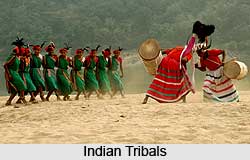 The Ministry of Tribal Affairs is the nodal Ministry for the overall policy, planning and coordination of programmes for the development of the Scheduled Tribes (STs). The programmes and schemes of the Ministry are intended to support and supplement, through financial assistance, the efforts of other Central Ministries, the State Governments and voluntary organization, and to fill critical gaps taking into account the needs of STs. To this end, the Ministry of Tribal Affairs undertakes activities that flow from the subjects allocated under the Government of India (Allocation of Buisness) Rules, 1961. Though the primary responsibility for promotion of interest of Scheduled Tribes rests with all the Central Ministries, the Ministry of Tribal Affairs complements their efforts by way of various developmental interventions in critical sectors through specially tailored schemes. These schemes which are for the economic, educational and social development are administered by the Ministry of Tribal of Affairs and implemented through the State Governments, Union Territory Administration and voluntary organizations.
The Ministry of Tribal Affairs is the nodal Ministry for the overall policy, planning and coordination of programmes for the development of the Scheduled Tribes (STs). The programmes and schemes of the Ministry are intended to support and supplement, through financial assistance, the efforts of other Central Ministries, the State Governments and voluntary organization, and to fill critical gaps taking into account the needs of STs. To this end, the Ministry of Tribal Affairs undertakes activities that flow from the subjects allocated under the Government of India (Allocation of Buisness) Rules, 1961. Though the primary responsibility for promotion of interest of Scheduled Tribes rests with all the Central Ministries, the Ministry of Tribal Affairs complements their efforts by way of various developmental interventions in critical sectors through specially tailored schemes. These schemes which are for the economic, educational and social development are administered by the Ministry of Tribal of Affairs and implemented through the State Governments, Union Territory Administration and voluntary organizations.
Organisation of Ministry of Tribal Affairs
The Ministry of Tribal affairs is functioning under the overall guidance of the Union Minister. The Ministry is organized into Divisions, Sections and Unit. Each division is headed by a Deputy Secretary/ Director. The Ministry of Tribal Affairs has a sanctioned strength of 131 employees (including 5 posts of PAO) and a working strength of 110. There are 33 group "A" posts, 51 group "B" posts, 31 group "C" posts and 16 group "D" posts. The establishment and general administration of the proper Ministry and the National Commission for Scheduled Tribes (NCST) are handled in the Administration Division. In addition, establishment matters of officers appointed under Central Staffing Scheme for the Department proper and ex-cadre posts, i.e. Economic Advisor, various Statistical Cadre, etc., are being administered in this Division.
Functions of Ministry of Tribal Affairs
The functions of the Ministry of tribal affairs are as follows- Social security and social insurance to the Scheduled Tribes; Tribal Welfare: Tribal welfare planning, project formulation, research, evaluation, statistics and training; Promotion and development of voluntary efforts on tribal welfare; Scheduled Tribes, including scholarship to students belonging to such tribes; Development of Scheduled Tribes 5(a) All matters including legislation relating to the rights of forest dwelling Scheduled Tribes on forest lands; Scheduled Areas; Matter relating to autonomous districts of Assam excluding roads and bridge works and ferries thereon; Regulations framed by the Governors of States for Scheduled Areas and for Tribal Areas specified in Part `A` of the Table appended to paragraph 20 of the Sixth Schedule to the Constitution of India; Commission to report on the administration of Scheduled Areas and the welfare of the Scheduled Tribes; and Issue of directions regarding the drawing up and execution of schemes essential for the welfare of the Scheduled Tribes in any State and the implementation of the Protection of Civil Rights Act, 1955 (22 of 1955) and the Scheduled Castes and the Scheduled Tribes (Prevention of Atrocities) Act, 1989 (33 of 1989), excluding administration of criminal justice in regard to offences in so far as they relate to Scheduled Tribes.




















